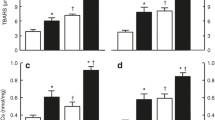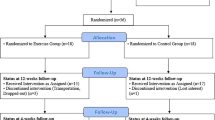Abstract
Purpose
To investigate the association of the hypothalamic-pituitary-testicular (HPT) axis with pro- and anti- oxidation, in relation to puberty and obesity in boys, before and after an aerobic exercise bout.
Methods
This is a cross-sectional human observational study of 92 healthy normal-weight, obese pre- and early- pubertal boys that underwent a blood sampling, before, and after an aerobic exercise bout at 70% VO2max, until exhaustion. LH, FSH, total testosterone (tT) and markers of pro- (TBARS and PCs) and anti- (GSH, GSSG, GPX, catalase, TAC) oxidation were measured.
Results
Baseline LH, FSH, and tT concentrations were greater in early, than in pre- pubertal boys, independently of weight status. Post-exercise, LH concentrations decreased in early pubertal boys while FSH concentrations did not change in any of the studied groups. Baseline and post-exercise tT concentrations were lower in obese than in normal-weight early pubertal boys, while baseline and post-exercise LH and FSH concentrations did not differ between these groups. Post-exercise tT concentrations increased in early pubertal obese boys. Baseline LH, FSH and tT concentrations correlated positively with baseline anti-oxidation markers concentrations in pre-pubertal boys. Baseline tT concentrations correlated positively with the increase of TAC concentrations in early pubertal normal-weight boys. In all boys, baseline LH concentrations were the best positive predictors for the exercise-associated increase of TAC concentrations.
Conclusions
It appears that the HPT axis maturation during puberty (in particular its LH and testosterone components) is positively associated with the increase of anti-oxidation during a bout of aerobic exercise.




Similar content being viewed by others
References
C.M. Burt Solorzano, C.R. McCartney, Obesity and the pubertal transition in girls and boys. Reproduction 140(3), 399–410 (2010). 140/3/399 [pii] https://doi.org/10.1530/REP-10-0119
J.D. Veldhuis, J.N. Roemmich, E.J. Richmond, C.Y. Bowers, Somatotropic and gonadotropic axes linkages in infancy, childhood, and the puberty-adult transition. Endocr. Rev. 27(2), 101–140 (2006). er.2005–0006 [pii] https://doi.org/10.1210/er.2005-0006
C. Ankarberg-Lindgren, E. Norjavaara, Changes of diurnal rhythm and levels of total and free testosterone secretion from pre to late puberty in boys: testis size of 3 ml is a transition stage to puberty. Eur. J. Endocrinol. 151(6), 747–757 (2004)
S. Vandewalle, Y. Taes, T. Fiers, M. Van Helvoirt, P. Debode, N. Herregods, C. Ernst, E. Van Caenegem, I. Roggen, F. Verhelle, J. De Schepper, J.M. Kaufman, Sex steroids in relation to sexual and skeletal maturation in obese male adolescents. J. Clin. Endocrinol. Metab. 99(8), 2977–2985 (2014). https://doi.org/10.1210/jc.2014-1452
C. Mammi, M. Calanchini, A. Antelmi, F. Cinti, G.M. Rosano, A. Lenzi, M. Caprio, A. Fabbri, Androgens and adipose tissue in males: a complex and reciprocal interplay. Int. J. Endocrinol. 2012, 789653 (2012). https://doi.org/10.1155/2012/789653
T. Finkel, N.J. Holbrook, Oxidants, oxidative stress and the biology of ageing. Nature 408(6809), 239–247 (2000). https://doi.org/10.1038/35041687
R.J. Alleman, L.A. Katunga, M.A. Nelson, D.A. Brown, E.J. Anderson, The “Goldilocks Zone” from a redox perspective-Adaptive vs. deleterious responses to oxidative stress in striated muscle. Front. Physiol. 5, 358 (2014). https://doi.org/10.3389/fphys.2014.00358
G. Paltoglou, I.G. Fatouros, G. Valsamakis, M. Schoina, A. Avloniti, A. Chatzinikolaou, A. Kambas, D. Draganidis, A. Mantzou, M. Papagianni, C. Kanaka-Gantenbein, G.P. Chrousos, G. Mastorakos, Anti-oxidation improves in puberty in normal weight and obese boys, in positive association with exercise-stimulated growth hormone secretion. Pediatr. Res. (2015). pr201585 [pii] https://doi.org/10.1038/pr.2015.85
A. Avloniti, A. Chatzinikolaou, C.K. Deli, D. Vlachopoulos, L. Gracia-Marco, D. Leontsini, D. Draganidis, A.Z. Jamurtas, G. Mastorakos, I.G. Fatouros, Exercise-Induced Oxidative Stress Responses in the Pediatric Population. Antioxidants (Basel) 6(1) (2017). E6 [pii] https://doi.org/10.3390/antiox6010006 antiox6010006 [pii]
R.B. Myers, T.O. Abney, The effects of reduced O2 and antioxidants on steroidogenic capacity of cultured rat Leydig cells. J. Steroid. Biochem. 31(3), 305–309 (1988)
R. Demirbag, R. Yilmaz, O. Erel, The association of total antioxidant capacity with sex hormones. Scand. Cardiovasc. J. 39(3), 172–176 (2005). U52785G321717601 [pii] https://doi.org/10.1080/14017430510035862
A. Mancini, E. Leone, R. Festa, G. Grande, A. Silvestrini, L. de Marinis, A. Pontecorvi, G. Maira, G.P. Littarru, E. Meucci, Effects of testosterone on antioxidant systems in male secondary hypogonadism. J. Androl. 29(6), 622–629 (2008). jandrol.107.004838 [pii] https://doi.org/10.2164/jandrol.107.004838
C. Skogastierna, M. Hotzen, A. Rane, L. Ekstrom, A supraphysiological dose of testosterone induces nitric oxide production and oxidative stress. Eur. J. Prev. Cardiol. 21(8), 1049–1054 (2014). 2047487313481755 [pii] https://doi.org/10.1177/2047487313481755
G. Mastorakos, M. Pavlatou, E. Diamanti-Kandarakis, G.P. Chrousos, Exercise and the stress system. Hormone 4(2), 73–89 (2005)
G. Gerra, R. Caccavari, N. Reali, P. Bonvicini, A. Marcato, G. Fertonani, R. Delsignore, M. Passeri, F. Brambilla, Noradrenergic and hormonal responses to physical exercise in adolescents. Relationship to anxiety and tolerance to frustration. Neuropsychobiology 27(2), 65–71 (1993). 118955 [pii] 118955
A.N. Elias, A.F. Wilson, Exercise and gonadal function. Hum. Reprod. 8(10), 1747–1761 (1993)
L. Di Luigi, C. Baldari, M.C. Gallotta, F. Perroni, F. Romanelli, A. Lenzi, L. Guidetti, Salivary steroids at rest and after a training load in young male athletes: relationship with chronological age and pubertal development. Int. J. Sports. Med. 27(9), 709–717 (2006). https://doi.org/10.1055/s-2005-872931
J.P. Ahtiainen, A. Pakarinen, W.J. Kraemer, K. Hakkinen, Acute hormonal and neuromuscular responses and recovery to forced vs maximum repetitions multiple resistance exercises. Int. J. Sports. Med. 24(6), 410–418 (2003). https://doi.org/10.1055/s-2003-41171
W.J. Kraemer, K. Hakkinen, R.U. Newton, B.C. Nindl, J.S. Volek, M. McCormick, L.A. Gotshalk, S.E. Gordon, S.J. Fleck, W.W. Campbell, M. Putukian, W.J. Evans, Effects of heavy-resistance training on hormonal response patterns in younger vs. older men. J. Appl. Physiol. 87(3), 982–992 (1999). https://doi.org/10.1152/jappl.1999.87.3.982
K. Fisher-Wellman, R.J. Bloomer, Acute exercise and oxidative stress: a 30 year history. Dyn. Med. 8, 1 (2009). 1476-5918-8-1 [pii] https://doi.org/10.1186/1476-5918-8-1
D. Chiotis, X. Krikos, G. Tsiftis, M. Hatzisymeon, M. Maniati-Christidi, A. Dacou-Voutetaki, Body mass index and prevalence of obesity in subjects of Hellenic origin aged 0–18 years living in the Athens area. Ann. Clin. Pediatr. Unive. Atheniensis. (51), 139–154 (2004)
T.J. Cole, M.C. Bellizzi, K.M. Flegal, W.H. Dietz, Establishing a standard definition for child overweight and obesity worldwide: international survey. BMJ 320(7244), 1240–1243 (2000)
J.D. Veldhuis, S.M. Pincus, R. Mitamura, K. Yano, N. Suzuki, Y. Ito, Y. Makita, A. Okuno, Developmentally delimited emergence of more orderly luteinizing hormone and testosterone secretion during late prepuberty in boys. J. Clin. Endocrinol. Metab. 86(1), 80–89 (2001)
K. Albertsson-Wikland, S. Rosberg, B. Lannering, L. Dunkel, G. Selstam, E. Norjavaara, Twenty-four-hour profiles of luteinizing hormone, follicle-stimulating hormone, testosterone, and estradiol levels: a semilongitudinal study throughout puberty in healthy boys. J. Clin. Endocrinol. Metab. 82(2), 541–549 (1997). https://doi.org/10.1210/jcem.82.2.3778
A.S. Kelly, J. Steinberger, T.P. Olson, D.R. Dengel, In the absence of weight loss, exercise training does not improve adipokines or oxidative stress in overweight children. Metabolism 56(7), 1005–1009 (2007). S0026-0495(07)00108-4 [pii] https://doi.org/10.1016/j.metabol.2007.03.009
E. von Elm, D.G. Altman, M. Egger, S.J. Pocock, P.C. Gotzsche, J.P. Vandenbroucke, The Strengthening the Reporting of Observational Studies in Epidemiology (STROBE) Statement: guidelines for reporting observational studies. Int. J. Surg. 12(12), 1495–1499 (2014). https://doi.org/10.1016/j.ijsu.2014.07.013. S1743-9191(14)00212-X [pii]
K.J. Teerds, D.G. de Rooij, J. Keijer, Functional relationship between obesity and male reproduction: from humans to animal models. Hum. Reprod. 17(5), 667–683 (2011). https://doi.org/10.1093/humupd. /dmr017 dmr017 [pii]
G. Paltoglou, M. Schoina, G. Valsamakis, N. Salakos, A. Avloniti, A. Chatzinikolaou, A. Margeli, C. Skevaki, M. Papagianni, C. Kanaka-Gantenbein, I. Papassotiriou, G.P. Chrousos, I.G. Fatouros, G. Mastorakos, Interrelations among the adipocytokines leptin and adiponectin, oxidative stress and aseptic inflammation markers in pre- and early-pubertal normal-weight and obese boys. Endocrine 55(3), 925–933 (2017). [pii] https://doi.org/10.1007/s12020-017-1227-3
G. Mastorakos, M. Pavlatou, Exercise as a stress model and the interplay between the hypothalamus-pituitary-adrenal and the hypothalamus-pituitary-thyroid axes. Horm. Metab. Res. 37(9), 577–584 (2005). https://doi.org/10.1055/s-2005-870426
T.B. Kelso, W.G. Herbert, F.C. Gwazdauskas, F.L. Goss, J.L. Hess, Exercise-thermoregulatory stress and increased plasma beta-endorphin/beta-lipotropin in humans. J. Appl. Physiol. 57(2), 444–449 (1984). https://doi.org/10.1152/jappl.1984.57.2.444
I.R. Thompson, U.B. Kaiser, GnRH pulse frequency-dependent differential regulation of LH and FSH gene expression. Mol. Cell Endocrinol. 385(1–2), 28–35 (2014). https://doi.org/10.1016/j.mce.2013.09.012. S0303-7207(13)00374-2 [pii]
J.D. Veldhuis, A.D. Rogol, E. Samojlik, N.H. Ertel, Role of endogenous opiates in the expression of negative feedback actions of androgen and estrogen on pulsatile properties of luteinizing hormone secretion in man. J. Clin. Invest. 74(1), 47–55 (1984). https://doi.org/10.1172/JCI111417
G. Valsamakis, G. Chrousos, G. Mastorakos, Stress, female reproduction and pregnancy. Psychoneuroendocrinology 100, 48–57 (2018). S0306-4530(18)30562-6 [pii] https://doi.org/10.1016/j.psyneuen.2018.09.031
J.L. Crawford, J.R. McNeilly, L. Nicol, A.S. McNeilly, Promotion of intragranular co-aggregation with LH by enhancement of secretogranin II storage resulted in increased intracellular granule storage in gonadotrophs of GnRH-deprived male mice. Reproduction 124(2), 267–277 (2002)
J.L. Crawford, A.S. McNeilly, Co-localisation of gonadotrophins and granins in gonadotrophs at different stages of the oestrous cycle in sheep. J. Endocrinol. 174(2), 179–194 (2002). JOE04737 [pii]
T. Watanabe, Y. Uchiyama, D. Grube, Topology of chromogranin A and secretogranin II in the rat anterior pituitary: potential marker proteins for distinct secretory pathways in gonadotrophs. Histochemistry 96(4), 285–293 (1991)
P.G. Farnworth, Gonadotrophin secretion revisited. How many ways can FSH leave a gonadotroph? J. Endocrinol. 145(3), 387–395 (1995)
A.S. McNeilly, J.L. Crawford, C. Taragnat, L. Nicol, J.R. McNeilly, The differential secretion of FSH and LH: regulation through genes, feedback and packaging. Reprod. Suppl. 61, 463–476 (2003)
L. Nicol, J.R. McNeilly, M. Stridsberg, A.S. McNeilly, Differential secretion of gonadotrophins: investigation of the role of secretogranin II and chromogranin A in the release of LH and FSH in LbetaT2 cells. J. Mol. Endocrinol. 32(2), 467–480 (2004)
D.C. Cumming, L.A. Brunsting 3rd, G. Strich, A.L. Ries, R.W. Rebar, Reproductive hormone increases in response to acute exercise in men. Med. Sci. Sports Exerc. 18(4), 369–373 (1986)
C. Enea, N. Boisseau, M. Ottavy, J. Mulliez, C. Millet, I. Ingrand, V. Diaz, B. Dugue, Effects of menstrual cycle, oral contraception, and training on exercise-induced changes in circulating DHEA-sulphate and testosterone in young women. Eur. J. Appl. Physiol. 106(3), 365–373 (2009). https://doi.org/10.1007/s00421-009-1017-6
K. Christiansen, Behavioural effects of androgen in men and women. J. Endocrinol. 170(1), 39–48 (2001). JOE04137 [pii]
M.S. Choi, B.A. Cooke, Evidence for two independent pathways in the stimulation of steroidogenesis by luteinizing hormone involving chloride channels and cyclic AMP. FEBS Lett. 261(2), 402–404 (1990)
S. Lee, R. Miselis, C. Rivier, Anatomical and functional evidence for a neural hypothalamic-testicular pathway that is independent of the pituitary. Endocrinology 143(11), 4447–4454 (2002). https://doi.org/10.1210/en.2002-220392
C.L. Fahrner, A.C. Hackney, Effects of endurance exercise on free testosterone concentration and the binding affinity of sex hormone binding globulin (SHBG). Int. J. Sports. Med. 19(1), 12–15 (1998). https://doi.org/10.1055/s-2007-971872
L.J. van Loon, P.L. Greenhaff, D. Constantin-Teodosiu, W.H. Saris, A.J. Wagenmakers, The effects of increasing exercise intensity on muscle fuel utilisation in humans. J. Physiol. 536(Pt 1), 295–304 (2001). PHY_12382 [pii]
D. Benitez-Sillero Jde, J.L. Perez-Navero, I. Tasset, M. Guillen-Del Castillo, M. Gil-Campos, I. Tunez, Influence of intense exercise on saliva glutathione in prepubescent and pubescent boys. Eur. J. Appl. Physiol. 106(2), 181–186 (2009). https://doi.org/10.1007/s00421-009-1004-y
Acknowledgements
This research did not receive any specific grant from any funding agency in the public, commercial or not-for-profit sector.
Author information
Authors and Affiliations
Corresponding author
Ethics declarations
Conflict of interest
The authors declare that they have no conflict of interest.
Ethical approval
This article does not contain any studies with animals performed by any of the authors. All procedures performed in the study involving human participants had the approval of the National and Kapodistrian University of Athens Medical School designated ethics committee and were in accordance with the 1964 Helsinki declaration and its later amendments.
Informed consent
The aims and the procedure of the study were fully disclosed to the parents or legal guardians of the participants, and informed, written consent was obtained from them while boys gave verbal consent before the participation in the study.
Additional information
Publisher’s note: Springer Nature remains neutral with regard to jurisdictional claims in published maps and institutional affiliations.
Rights and permissions
About this article
Cite this article
Paltoglou, G., Avloniti, A., Chatzinikolaou, A. et al. In early pubertal boys, testosterone and LH are associated with improved anti-oxidation during an aerobic exercise bout. Endocrine 66, 370–380 (2019). https://doi.org/10.1007/s12020-019-02037-1
Received:
Accepted:
Published:
Issue Date:
DOI: https://doi.org/10.1007/s12020-019-02037-1




